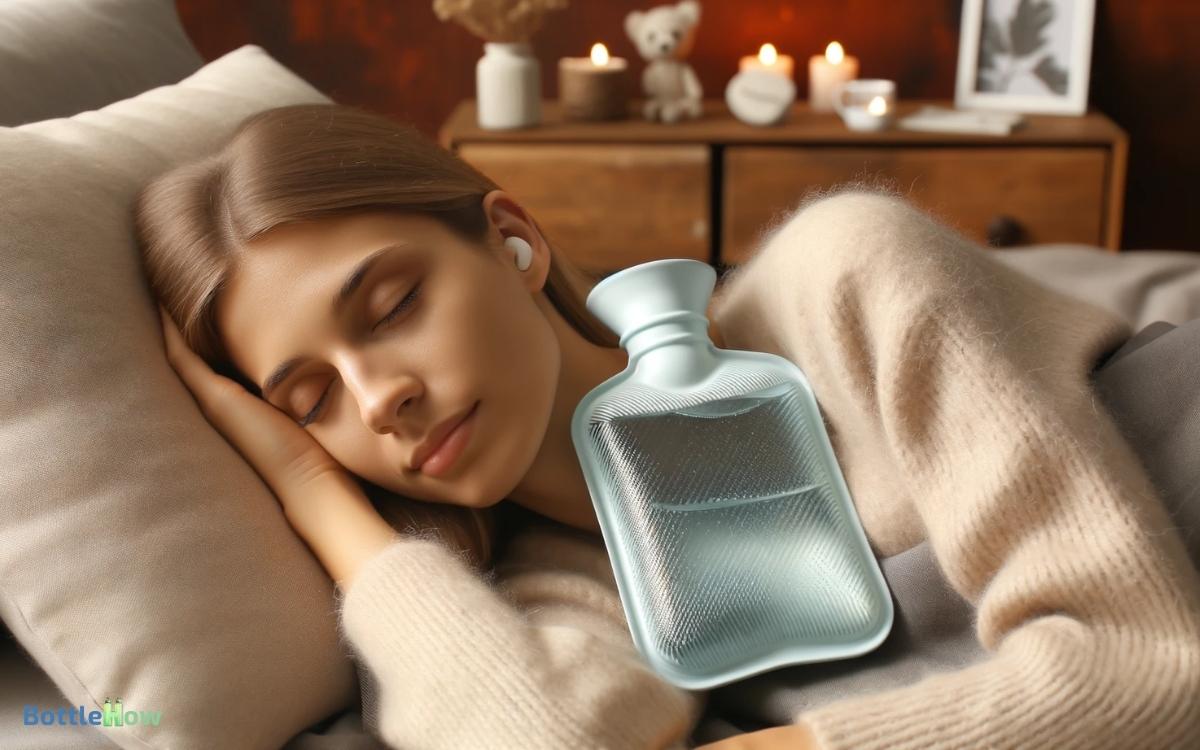Does a Hot Water Bottle Help Blocked Ears? Yes!
Yes, a hot water bottle can help relieve blocked ears. By increasing blood flow to the area and reducing inflammation, the heat can alleviate the sensation of fullness and discomfort.
Make sure the water temperature is between 104°F to 113°F and use a towel as a barrier to prevent burns. However, avoid using heat therapy if you have an ear infection or recent surgery.
While effective, this method is best combined with other remedies and early symptom recognition for best results. To explore additional treatments and precautions, continue learning more about this topic.

Key Takeaways
Understanding Blocked Ears
Blocked ears occur when there’s an obstruction in the ear canal, often caused by earwax buildup, fluid, or inflammation.
When you experience this, you might notice a reduction in hearing sensitivity, a sensation of fullness, or even discomfort.
Your Eustachian tube, which helps equalize pressure in your ears, can also get blocked, leading to similar symptoms. It’s crucial to understand that this condition can affect your balance and hearing.
Different mechanisms, including the accumulation of cerumen (earwax) and Eustachian tube dysfunction, contribute to the blockage. The obstruction can impede sound transmission, leading to temporary hearing loss.
Recognizing the symptoms early can help you seek appropriate treatment and avoid potential complications, such as infections or prolonged discomfort.
Common Causes of Blocked Ears
Several factors can lead to the obstruction of the ear canal, directly impacting your auditory function.
- Earwax buildup is a common cause; your body naturally produces this substance, but excess can hinder sound waves.
- Eustachian tube dysfunction, often due to sinus infections or allergies, prevents normal fluid drainage, creating a blockage.
- Foreign objects, especially in children, can also obstruct the ear canal.
- Otitis externa, or swimmer’s ear, results from water trapped in the ear, fostering bacterial growth.
- Lastly, rapid pressure changes, such as those experienced during flights or scuba diving, can cause barotrauma, leading to ear blockage.
Understanding these causes helps you identify potential issues and seek appropriate treatment.
Symptoms of Blocked Ears
You may experience muffled hearing, a feeling of fullness, or even pain when your ears are blocked. These symptoms can affect your daily life and may be indicative of underlying issues.
Here are some key symptoms to look out for:
- Muffled Hearing: Sounds may seem distant or less clear.
- Fullness in the Ear: A sensation as if your ear is filled with fluid or plugged.
- Ear Pain: Ranging from mild discomfort to sharp pain.
- Tinnitus: Ringing, buzzing, or other noises in the ear without an external source.
Recognizing these symptoms early can help in seeking appropriate treatment. Remember, a blocked ear can result from various causes, so understanding the symptoms is essential for effective management and relief.
Traditional Remedies for Blocked Ears
In conclusion, recognizing the symptoms of blocked ears is the first step to exploring traditional remedies that have been used for generations to alleviate discomfort and restore hearing.
One common practice is using steam inhalation. By inhaling steam, you can help loosen the earwax and relieve congestion.
Another method involves using olive oil drops. A few warmed drops can soften earwax, making it easier to remove.
Gargling saltwater is also recommended; it can reduce inflammation and promote drainage. To wrap up, chewing gum stimulates the Eustachian tubes, helping to equalize ear pressure.
These methods are rooted in traditional practices, offering gentle and non-invasive ways to address ear blockage. Always consult a healthcare professional before trying these remedies.
How Heat Affects Blocked Ears
Applying heat to blocked ears can help increase blood flow and loosen congestion, potentially providing relief.
When you apply heat, it can influence the ear’s physiology by:
- Increasing Circulation: Heat dilates blood vessels, promoting blood flow to the ear area.
- Soothing Muscles: Warmth can relax tense muscles around the ear, reducing discomfort.
- Thinning Secretions: Heat may help thin mucus, making it easier for your body to expel it.
- Reducing Inflammation: Increased blood flow can help reduce inflammation, alleviating pressure in the ear.
These effects collectively may ease the symptoms of blocked ears. Scientific studies support that heat applications can be beneficial, though the exact mechanisms can vary.
Always make sure the heat source is at a safe temperature to prevent burns.
Benefits of Using Heat
Increased blood flow from heat application can expedite the healing process for blocked ears. Applying heat improves circulation, which can help reduce inflammation and alleviate discomfort.
Enhanced blood flow delivers oxygen and essential nutrients to the affected area, promoting cellular repair.
Heat can also soften earwax, making it easier for the body to expel it naturally. Additionally, the warmth can relax the muscles around the ear, potentially relieving pressure and improving drainage.
Studies have shown that thermal therapy can be effective in managing pain and discomfort in various conditions, including ear blockages.
Using a Hot Water Bottle
When using a hot water bottle for blocked ears, you’ll benefit from the heat’s ability to improve blood circulation and reduce discomfort.
Make sure you follow safety precautions, like wrapping the bottle in a cloth to prevent burns. This method should be used under supervision if you have any underlying conditions.
Heat Application Benefits
Using a hot water bottle can help alleviate blocked ears by promoting blood circulation and reducing inflammation.
Heat application is known to dilate blood vessels, which can enhance the supply of oxygen and nutrients to the affected area.
Additionally, it can help in loosening any mucus buildup and easing muscle tension around the ear.
Here are four benefits of using a hot water bottle for blocked ears:
- Enhanced Blood Flow: Increases circulation, aiding in quicker recovery.
- Reduced Inflammation: Heat can decrease swelling in the ear canal.
- Mucus Liquefaction: Helps to thin and break down mucus, easing drainage.
- Muscle Relaxation: Reduces tension in the surrounding muscles, providing relief.
Safety Precautions
Guaranteeing the safe use of a hot water bottle involves checking for leaks and regulating the temperature to prevent burns. Inspect the bottle for any damage or wear before each use.
Fill the bottle with hot, but not boiling, water to reduce the risk of scalding. Always use a cover to provide an additional layer of protection.
Limit the contact time to 20 minutes to avoid skin irritation. Don’t place the hot water bottle directly on your ear; instead, wrap it in a cloth for indirect heat application.
Keep the bottle out of reach of children and pets. Following these guidelines ensures you can safely benefit from the heat while minimizing potential risks.
Steps to Use a Hot Water Bottle
To effectively use a hot water bottle for blocked ears, start by filling it two-thirds full with hot, but not boiling, water to prevent burns. Make sure the cap is tightly closed to avoid leaks.
Follow these steps to maximize efficacy:
- Wrap the Bottle: Use a soft cloth to wrap the hot water bottle, making sure it’s not in direct contact with your skin.
- Position Correctly: Lie on your side with the blocked ear facing up. Place the wrapped bottle against the blocked ear.
- Duration: Keep the bottle in place for 15-20 minutes. Remove if discomfort arises.
- Repeat as Needed: Use the hot water bottle multiple times a day to help alleviate ear blockage.
These steps can help relieve blocked ears efficiently.
Safety Tips and Precautions
When using a hot water bottle for blocked ears, it’s important to ensure that the water temperature isn’t too hot to prevent burns.
Always use a cloth cover or towel to avoid direct contact with the skin. Monitoring the heat level and duration of application can greatly reduce the risk of injury.
Proper Temperature Control
Maintaining the accurate temperature of a hot water bottle is essential to prevent burns and guarantee safe application for blocked ears. You need to be meticulous with temperature control to avoid any risk of injury.
Here’s a precise guideline for proper temperature management:
- Fill Water Below Boiling Point: Use water that’s around 104°F (40°C) to 113°F (45°C). Boiling water increases burn risk.
- Check for Leaks: Guarantee the bottle has no leaks by conducting a brief pressure test.
- Use a Thermometer: Verify water temperature with a thermometer before application.
- Change Water Regularly: Refresh the water every 20-30 minutes to maintain the ideal heat and prevent overheating.
Avoid Direct Contact
It is essential to make sure the hot water bottle doesn’t come into direct contact with the skin to prevent burns and skin irritation.
Always use a cover or wrap the bottle in a towel. Direct contact can lead to thermal injuries, especially for sensitive areas like the ears.
Follow these guidelines to maintain safety:
| Issue | Precaution |
|---|---|
| Burns | Use a cover or towel |
| Skin irritation | Limit exposure time |
| Overheating | Monitor water temperature |
| Leakage | Inspect for damage |
Maintain a barrier between the hot water bottle and your skin. This reduces the risk of burns while ensuring the heat effectively alleviates ear discomfort.
Always check the bottle for damages to avoid leaks. These precautions will make your experience both safe and effective.
Situations to Avoid Heat Therapy
Patients should avoid heat therapy if they’ve an ear infection, as the increased warmth can exacerbate inflammation and potentially worsen the condition.
You should also consider other situations where heat therapy might be counterproductive:
- Recent Ear Surgery: Heat can interfere with the healing process and increase the risk of complications.
- Severe Swelling: Heat can exacerbate swelling and impede recovery.
- Open Wounds or Sores: Applying heat to broken skin can introduce bacteria and cause infections.
- Diabetes or Poor Circulation: These conditions can reduce your ability to sense temperature changes, leading to burns or further complications.
It’s essential to evaluate your specific condition and consult a healthcare provider before using heat therapy for blocked ears.
Alternative Remedies to Try
You can consider alternative remedies like using a warm compress to reduce ear congestion.
Applying natural oils, such as olive oil, may help alleviate discomfort. Additionally, steam inhalation techniques can effectively open up blocked ear passages.
Warm Compress Benefits
Applying a warm compress to the ear can alleviate discomfort by improving blood circulation and reducing inflammation.
This method is grounded in evidence-based practices that show heat can soothe discomfort and support healing processes.
Here are four benefits of using a warm compress:
- Enhanced Blood Flow: Heat increases circulation, delivering essential nutrients and oxygen to the affected area.
- Reduced Inflammation: Warmth helps to decrease swelling and pressure, which can contribute to ear discomfort.
- Muscle Relaxation: The application of heat can relax surrounding muscles, reducing tension and associated pain.
- Pain Relief: The soothing effect of a warm compress can provide immediate, albeit temporary, relief from ear pain.
Natural Oils Usage
In addition to warm compresses, natural oils like olive oil, tea tree oil, and garlic oil can serve as effective alternative remedies for blocked ears.
Olive oil can help soften earwax, making it easier to remove. Simply warm a few drops and apply them to the ear canal.
Tea tree oil, known for its antimicrobial properties, can help combat infections that might be causing blockage. Dilute it with a carrier oil before application.
Garlic oil, rich in allicin, offers antibacterial benefits. Warm a few drops and gently administer it into the ear.
Always make sure the oils are at a safe temperature and consult a healthcare professional before use to avoid potential complications or contraindications.
Steam Inhalation Techniques
Although often overlooked, steam inhalation techniques can effectively alleviate blocked ears by loosening mucus and reducing inflammation in the Eustachian tubes.
Here’s how you can implement this technique:
- Boil Water: Bring a pot of water to a rolling boil, then remove it from heat.
- Create a Tent: Drape a towel over your head and the pot to trap the steam.
- Inhale Deeply: Lean over the pot and inhale the steam deeply through your nose and mouth for 5-10 minutes.
- Repeat as Needed: Perform this technique 2-3 times daily for best results.
These steps help maintain the proper humidity to reduce congestion and facilitate the natural drainage of fluids, ultimately providing relief for blocked ears.
When to See a Doctor
You should see a doctor if your blocked ears persist for more than a week or if you experience severe pain or hearing loss. Persistent symptoms could indicate an underlying condition requiring medical intervention.
Other red flags include dizziness, fever, or discharge from the ear. These symptoms may suggest an infection or other serious issues.
| Symptom | Possible Condition | Action Required |
|---|---|---|
| Blocked ears > 1 week | Chronic Eustachian tube dysfunction | Consult a doctor |
| Severe pain | Infection, injury | Immediate medical attention |
| Hearing loss | Earwax impaction, infection | Professional evaluation |
| Dizziness | Inner ear disorder | Schedule a check-up |
| Fever, discharge | Ear infection | Seek medical advice |
Timely consultation guarantees proper diagnosis and treatment.
Conclusion
Imagine your ears as a congested highway; applying heat, like a hot water bottle, can act as a gentle traffic controller, easing the flow.
However, it’s important to steer clear of potential hazards by using heat responsibly. While this method can offer relief, it’s not a universal solution.
Consider other remedies and consult a doctor if symptoms persist. Your ears deserve the same care and precision you’d give to any intricate system.






